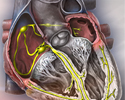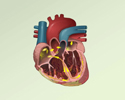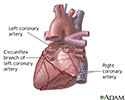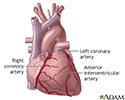Atrial fibrillation or flutter
Auricular fibrillation; A-fib; Afib
Atrial fibrillation or flutter is a common type of abnormal heartbeat. The heart rhythm is fast and most often irregular.
Causes
When working well, the 4 chambers of the heart contract (squeeze) in an organized way.
Electrical signals direct your heart to pump the right amount of blood for your body's needs. The signals begin in an area called the sinoatrial node (also called the sinus node or SA node).
In atrial fibrillation, the electrical impulse of the heart is not regular. This is because the sinoatrial node no longer controls the heart rhythm.
- Parts of the heart cannot contract in an organized pattern.
- As a result, the heart cannot pump enough blood to meet the body's needs.
In atrial flutter, the ventricles (lower heart chambers) may beat very rapidly, but in a regular pattern.
These problems can affect both men and women. They become more common with increasing age.
Common causes of atrial fibrillation include:
- Alcohol use (especially binge drinking)
-
Coronary artery disease
Coronary artery disease
Coronary heart disease is a narrowing of the small blood vessels that supply blood and oxygen to the heart. Coronary heart disease (CHD) is also cal...
 ImageRead Article Now Book Mark Article
ImageRead Article Now Book Mark Article - Heart attack or heart bypass surgery
-
Heart failure
or an enlarged heart
Heart failure
Heart failure is a condition in which the heart is no longer able to pump oxygen-rich blood to the rest of the body efficiently. This causes symptom...
 ImageRead Article Now Book Mark Article
ImageRead Article Now Book Mark Article - Heart valve disease (most often the mitral valve)
- Hypertension
- Medicines
-
Overactive thyroid gland (
hyperthyroidism
)
Hyperthyroidism
Hyperthyroidism is a condition in which the thyroid gland makes too much thyroid hormone. The condition is often called overactive thyroid.
 ImageRead Article Now Book Mark Article
ImageRead Article Now Book Mark Article -
Pericarditis
Pericarditis
Pericarditis is a condition in which the sac-like covering around the heart (pericardium) becomes inflamed.
 ImageRead Article Now Book Mark Article
ImageRead Article Now Book Mark Article -
Sick sinus syndrome
Sick sinus syndrome
Normally, the heartbeat starts in an area in the top chambers of the heart (atria). This area is the heart's pacemaker. It may be called the sinoat...
 ImageRead Article Now Book Mark Article
ImageRead Article Now Book Mark Article
Symptoms
You may not be aware that your heart is not beating in a normal pattern.
Symptoms may start or stop suddenly. This is because atrial fibrillation may stop or start on its own.
Symptoms may include:
- Pulse that feels rapid, racing, pounding, fluttering, irregular, or too slow
-
Sensation of feeling the heart beat (
palpitations
)
Palpitations
Palpitations are feelings or sensations that your heart is pounding or racing. They can be felt in your chest, throat, or neck. You may:Have an unpl...
 ImageRead Article Now Book Mark Article
ImageRead Article Now Book Mark Article -
Confusion
Confusion
Confusion is the inability to think as clearly or quickly as you normally do. You may feel disoriented and have difficulty paying attention, remembe...
 ImageRead Article Now Book Mark Article
ImageRead Article Now Book Mark Article -
Dizziness
, lightheadedness
Dizziness
Dizziness is a term that is often used to describe 2 different symptoms: lightheadedness and vertigo. Lightheadedness is a feeling that you might fai...
 ImageRead Article Now Book Mark Article
ImageRead Article Now Book Mark Article -
Fainting
Fainting
Fainting is a brief loss of consciousness due to a drop in blood flow to the brain. The episode most often lasts less than a couple of minutes and y...
Read Article Now Book Mark Article -
Fatigue
Fatigue
Fatigue is a feeling of weariness, tiredness, or lack of energy.
Read Article Now Book Mark Article - Loss of ability to exercise
- Shortness of breath
Exams and Tests
The health care provider may hear a fast heartbeat while listening to your heart with a stethoscope. Your pulse may feel fast, uneven, or both.
The normal heart rate is 60 to 100 beats per minute. In atrial fibrillation or flutter, the heart rate may be 100 to 175 beats per minute. Blood pressure may be normal or low.
An ECG (a test that records the electrical activity of the heart) may show atrial fibrillation or atrial flutter.
ECG
An electrocardiogram (ECG) is a test that records the electrical activity of the heart.

If your abnormal heart rhythm comes and goes, you may need to wear a special monitor to diagnose the problem. The monitor records the heart's rhythms over a period of time.
- Event monitor (3 to 4 weeks)
-
Holter monitor
(24-hour test)
Holter monitor
A Holter monitor is a machine that continuously records the heart's rhythms. The monitor is worn for 24 to 48 hours during normal activity.
 ImageRead Article Now Book Mark Article
ImageRead Article Now Book Mark Article - Implanted loop recorder (extended monitoring)
Tests to find heart disease may include:
- Echocardiogram (ultrasound imaging of the heart)
- Tests to examine the blood supply of the heart muscle
-
Tests to study the heart's electrical system
Tests to study the heart's electrical s...
Intracardiac electrophysiology study (EPS) is a test to look at how well the heart's electrical signals are working. It is used to check for abnorma...
 ImageRead Article Now Book Mark Article
ImageRead Article Now Book Mark Article
Treatment
Cardioversion treatment is used to get the heart back into a normal rhythm right away. There are two options for treatment:
- Electric shocks to your heart
- Drugs given through a vein
These treatments may be done as emergency methods, or planned ahead of time.
Daily medicines taken by mouth are used to:
- Slow the irregular heartbeat. These drugs may include beta-blockers, calcium channel blockers, and digoxin.
- Prevent atrial fibrillation from coming back. These drugs work well in many people, but they can have serious side effects. Atrial fibrillation returns in many people, even while they are taking these medicines.
Blood thinners are medicines that are used to reduce the risk of developing a blood clot that travels in the body (and that can cause a stroke, for example). They include heparin , warfarin (Coumadin), apixaban (Eliquis), rivaroxaban (Xarelto), and dabigatran (Pradaxa).
Blood thinners
What to ask your doctor about heartburn and reflux; Reflux - what to ask your doctor; GERD - what to ask your doctor; Gastroesophageal reflux disease...
Heparin
DVT - heparin shot; Deep venous thrombosis - heparin shot; PE - heparin shot; Pulmonary embolism - heparin shot; Blood thinner - heparin shot; Antico...
Warfarin
Warfarin is a medicine that makes your blood less likely to form clots. This may be important if:You have already had blood clots in your leg, arm, ...
These drugs increase the chance of bleeding, so not everyone can use them. Antiplatelet drugs such as aspirin or clopidogrel may also be prescribed. Your provider will consider your age and other medical problems when deciding which drugs are best.
Aspirin
Warfarin is a medicine that makes your blood less likely to form clots. This may be important if:You have already had blood clots in your leg, arm, ...
Clopidogrel
Blood thinners - clopidogrel; Antiplatelet therapy - clopidogrel; Thienopyridines

A procedure called radiofrequency ablation can be used to scar areas in your heart where the heart rhythm problems are triggered. This can prevent the abnormal electrical signals that cause atrial fibrillation or flutter from moving through the heart. You may need a heart pacemaker after this procedure. All people with atrial fibrillation will need to learn how to manage this condition at home .
Radiofrequency ablation
Cardiac ablation is a procedure that is used to scar small areas in your heart that may be involved in your heart rhythm problems. This can prevent ...
Pacemaker
A pacemaker is a small, battery-operated device. This device senses when your heart is beating irregularly or too slowly. It sends a signal to your...

Manage this condition at home
You may have been in the hospital because you have atrial fibrillation. This condition occurs when your heart beats faster than normal or in an irre...
Outlook (Prognosis)
Treatment can often control this disorder. Many people with atrial fibrillation do very well.
Atrial fibrillation tends to return and get worse. It may come back, even with treatment.
Clots that break off and travel to the brain can cause a stroke .
Stroke
A stroke occurs when blood flow to a part of the brain stops. A stroke is sometimes called a "brain attack. " If blood flow is cut off for longer th...

When to Contact a Medical Professional
Call your provider if you have symptoms of atrial fibrillation or flutter.
Prevention
Talk to your provider about steps to treat conditions that cause atrial fibrillation and flutter. Avoid binge drinking.
References
January CT, Wann LS, Alpert JS, et al. 2014 AHA/ACC/HRS guideline for the management of patients with atrial fibrillation: a report of the American College of Cardiology/American Heart Association Task Force on Practice Guidelines and the Heart Rhythm Society. Circulation . 2014;130(23):2071-2104. PMID: 24682348 www.ncbi.nlm.nih.gov/pubmed/24682348 .
Meschia JF, Bushnell C, Boden-Albala B, et al. Guidelines for the primary prevention of stroke: a statement for healthcare professionals from the American Heart Association/American Stroke Association. Stroke . 2014;45(12):3754-3832. PMID: 25355838 www.ncbi.nlm.nih.gov/pubmed/25355838 .
Morady F, Zipes DP. Atrial fibrillation: clinical features, mechanisms, and management. In: Mann DL, Zipes DP, Libby P, Bonow RO, Braunwald E, eds. Braunwald's Heart Disease: A Textbook of Cardiovascular Medicine . 10th ed. Philadelphia, PA: Elsevier Saunders; 2015:chap 38.
Olgin JE, Zipes DP. Specific arrhythmias: diagnosis and treatment. In: Mann DL, Zipes DP, Libby P, Bonow RO, Braunwald E, eds. Braunwald's Heart Disease: A Textbook of Cardiovascular Medicine . 10th ed. Philadelphia, PA: Elsevier Saunders; 2015:chap 37.
Zimetbaum P. Cardiac arrhythmia with supraventricular origin. In: Goldman L, Schafer AI, eds. Goldman's Cecil Medicine . 25th ed. Philadelphia, PA: Elsevier Saunders; 2016:chap 64.
-
Atrial fibrillation
Animation
-
Atrial fibrillation overview
Animation
-
Heart, section through the middle - illustration
The interior of the heart is composed of valves, chambers, and associated vessels.
Heart, section through the middle
illustration
-
Heart, front view - illustration
The external structures of the heart include the ventricles, atria, arteries and veins. Arteries carry blood away from the heart while veins carry blood into the heart. The vessels colored blue indicate the transport of blood with relatively low content of oxygen and high content of carbon dioxide. The vessels colored red indicate the transport of blood with relatively high content of oxygen and low content of carbon dioxide.
Heart, front view
illustration
-
Posterior heart arteries - illustration
The coronary arteries supply blood to the heart muscle. The right coronary artery supplies both the left and the right heart; the left coronary artery supplies the left heart.
Posterior heart arteries
illustration
-
Anterior heart arteries - illustration
The coronary arteries supply blood to the heart muscle. The right coronary artery supplies both the left and the right heart; the left coronary artery supplies the left heart.
Anterior heart arteries
illustration
-
Conduction system of the heart - illustration
The intrinsic conduction system sets the basic rhythm of the beating heart by generating impulses which stimulate the heart to contract.
Conduction system of the heart
illustration
-
Heart, section through the middle - illustration
The interior of the heart is composed of valves, chambers, and associated vessels.
Heart, section through the middle
illustration
-
Heart, front view - illustration
The external structures of the heart include the ventricles, atria, arteries and veins. Arteries carry blood away from the heart while veins carry blood into the heart. The vessels colored blue indicate the transport of blood with relatively low content of oxygen and high content of carbon dioxide. The vessels colored red indicate the transport of blood with relatively high content of oxygen and low content of carbon dioxide.
Heart, front view
illustration
-
Posterior heart arteries - illustration
The coronary arteries supply blood to the heart muscle. The right coronary artery supplies both the left and the right heart; the left coronary artery supplies the left heart.
Posterior heart arteries
illustration
-
Anterior heart arteries - illustration
The coronary arteries supply blood to the heart muscle. The right coronary artery supplies both the left and the right heart; the left coronary artery supplies the left heart.
Anterior heart arteries
illustration
-
Conduction system of the heart - illustration
The intrinsic conduction system sets the basic rhythm of the beating heart by generating impulses which stimulate the heart to contract.
Conduction system of the heart
illustration
Review Date: 4/20/2015
Reviewed By: Michael A. Chen, MD, PhD, Associate Professor of Medicine, Division of Cardiology, Harborview Medical Center, University of Washington Medical School, Seattle, WA. Internal review and update on 07/24/2016 by David Zieve, MD, MHA, Isla Ogilvie, PhD, and the A.D.A.M. Editorial team.









